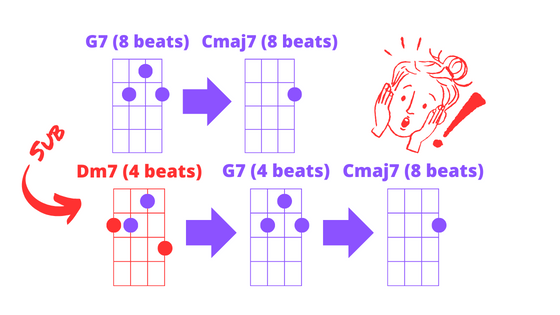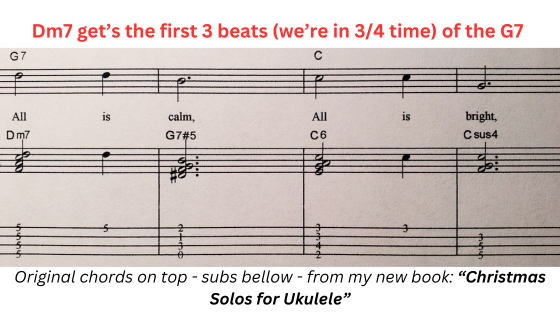It's easy to use!
You will Learn More and Play More with Play Ukulele NOW.
Find out for yourself why teachers and students have depended on Play Ukulele NOW Methods and Songbooks since 2009
Find out for yourself why teachers and students have depended on Play Ukulele NOW Methods and Songbooks since 2009
DISCLOSURE: THIS POST MAY CONTAIN AFFILIATE LINKS, MEANING I GET A COMMISSION IF YOU DECIDE TO MAKE A PURCHASE THROUGH MY LINKS, AT NO COST TO YOU. PLEASE READ MY DISCLOSURE FOR MORE INFO.
Find all my chord related posts here: Chord Tips and Tricks
Learn the simple rule
You'll find this all the time in Jazz and you may not know what it is when you see it because it's so wild! When students first encounter this they say "What in the word are they doing?"
As often as you see this it's surprising that when people have articles of various chord substitution tricks this is never included.
As a result, outside of seasoned jazz players, no one knows about this - could be used in all styles of music.
I released a new Christmas book this year "Christmas Songs for Ukulele" where I jazz up some of the songs and I use this trick in every arrangement that I jazz up... (in some way shape or form).
RULE:
- Any dominant may be substituted for a minor 7 a 5th higher for 2-4 beats.
- Typically (but not always) the minor 7 borrows a few beats of the dominant and the dominant still gets the last few beats.
See it in action
Here we take a look it how it can be used in an actual song.
EXAMPLE (Silent Night):
- ORIGINAL: (G7) All is calm, All (C) All is bright.
- WITH SUB's: (Dm7) All is (G7#5) Calm, (C6) All is (Csus4) bright.
Silent Night, measures 5-8 (you can click on the picture(s) and zoom in to see the TAB better if you like):
This can be used on other chords as well - as we know any chord can be a dominant - so dominant subs can be used for any chord.
Check this out...
EXAMPLE 2 (Silent Night):
- ORIGINAL: (G7) Sleep in heavenly (C) peace
- WITH SUB's: (Dm7) Sleep in (G7) heav - (G#dim) - enly (Gm11) peace (D13) ___ (C6) Sleep in...
Silent Night, measures 17-20 (in measure 21 - not shown - we have a C6 while "sleep in..." is sung):
Here we have the Dm7 for the first three beats of the G7 like we did before, in this example we also use it as a sub for the I chord we see it here as an embellished chord - we then do the the V chord of the G, D13 (could call it an Am6/9 - same chord and a relative minor of the C) which shares 3 notes with the Cmaj7.
We do get the original chord after the substitutions (Gm11 - D13 - C6) while the piece originally called for a C during this whole time. So we are borrowing beats from the original chord with the sub's and winding up on the original chord at the end.
How can we do it for the I chord? If any cord can be a dominant and this is a dominant sub then we could do it for any chord!
It is possible to do this sub and not wind up on the original chord at the end as well.
As a general rule if a chord share 2 notes it can be used as a substitute.
In my new book "Christmas Solos for Ukulele" I use this substitution in all the songs I 'jazz up' and I use it in quite a few different ways. The examples here are from the jazz version of 'Silent Night' that's in the book - patreon members get this whole book for free!
Now you're ready to use this top notch substitution trick!
Want more?
Check out my chord related books below. Create beautiful chord progressions in any key and learn to simplify any chord.
Secrets of the Chord Chain: Major and Minor Chord Progressions for the Ukulele
I wish I had books like this when I started playing!
Would have saved me years of frustration.
The great new is you can have them now—In the books I unlock the mysteries of great chord progressions for you and make it so simple to understand that you will be able to create beautiful music right away!
Everything you need to play stunning chord progressions in any key and to fully understand how chord progressions are created and where they come from is here.
Links leads to the books on amazon...
Secrets of the Chord Chain Complete - Major and Minor Chord Progressions for the Ukulele (SAVE WHEN YOU BUY THE COMPLETE EDITION - Books 1 & 2 - 130 pages!)
Ukulele Chord Tricks: Simplify Any Chord
There is! This book will solve all of your chord problems...
Any chord can be simplified - in this book I walk you through how to do it with many tricks that the pros know and use all the time!
Get your paperback on Amazon: Ukulele Chord Tricks - Simplify Any Chord (this leads to the book on amazon and you can preview quite a few pages to check it out)
Get the eBook (instant download): Ukulele Chord Tricks: Simplify Any Chord
Get just one chapter: E Chord and Progression Tricks; E Minor Chord and Progression Tricks; two chapters (they go together): Triads & Accompaniment Patterns Some of these are available FREE to patreon members.
Conclusion
Questions about this? Drop a comment below.













No comments:
Post a Comment